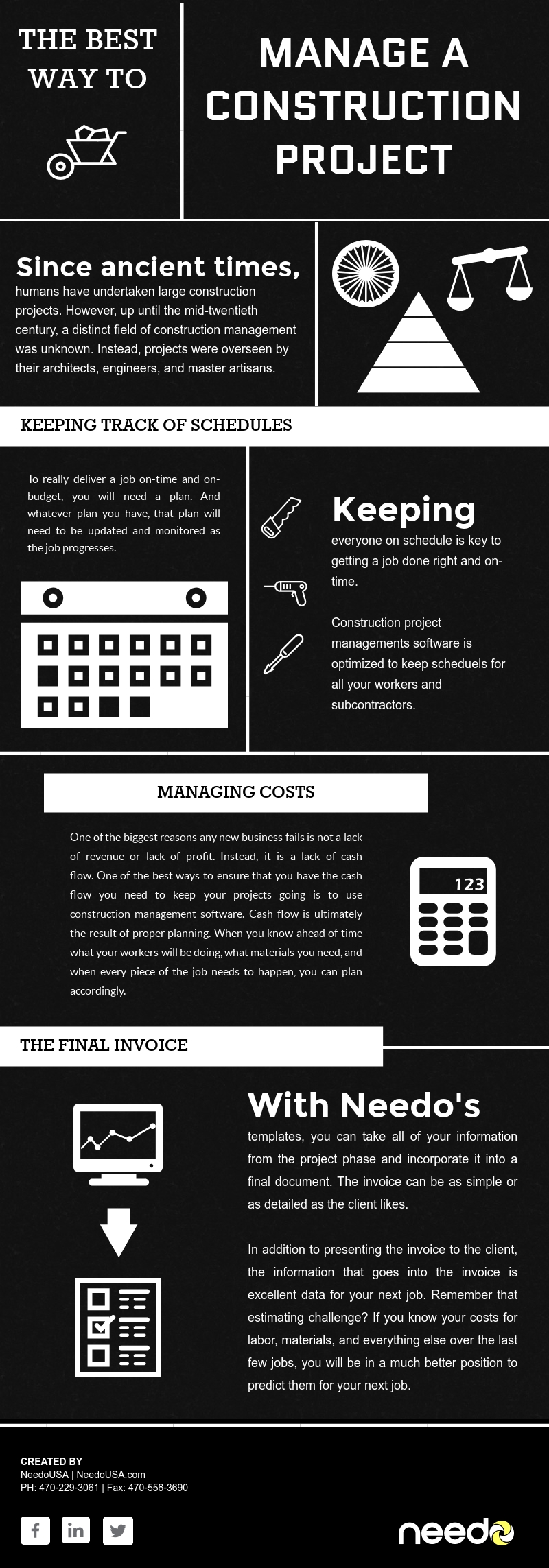Construction project management is as old as construction itself. From the time of the great pyramids, workers, materials, and other resources had to be managed to successfully complete a project. Over the course of millennia, the way construction projects have been run has shifted, but the question remains the same: What is the best way to manage a construction project?

The History of Construction Project Management
Since ancient times, humans have undertaken large construction projects. Some projects, like the great pyramids, still stand 4000 years after their construction. The Roman aqueducts built two millennia ago still exist in some sections and represent a tremendous feat of planning. However, up until the mid-twentieth century, a distinct field of construction management was unknown. Instead, projects were overseen by their architects, engineers, and master artisans.
In the 1950s, project management as a distinct field developed out of the fields of civil construction, engineering, and military planning. Today, construction management on large projects can be done by a designated manager or even by a team. However, for many smaller projects, the general contractor remains in charge of construction project management.
As a general contractor, you may find that your skills as a planner and manager are just as important and even more important than your skills as a master of your craft. If you are also the proprietor of your own business, you can add entrepreneur to the list of hats you wear and skills you need.
Start With the Bid
There are several parts to managing a construction project. The first and arguably most important step is the bid. Bidding on a project is where you get to determine how much you will make on a job. If you bid too high, you may miss out on work as other contractors underbid you. But if you set your bid too low, you run the risk of making too little profit or even losing money. A series of underestimated bids could be the end of your business.
Preparing a bid is tricky work. Some larger companies hire estimators whose sole profession is the preparation of accurate and reliable estimates that can be used for bidding out jobs. If you are lucky enough to have an estimator, some of that work can be taken off your plate. But whether or not you have someone to do it for you, estimating and bidding is a fraught process.
This is one area where modern technology can lend a huge helping hand. Once upon a time, the best tools for estimating were experience and piles of paper records. A contractor or estimator had to possess a knowledge of all of the crafts necessary for a project, their general costs, and how they all fit together. Paper records could help substantiate labor, material, and equipment costs. It could take weeks or even months to prepare a final estimate.
In today’s fast-paced work climate, weeks is far too long to prepare an estimate. Contractors need to prepare estimates quickly and revise them even more quickly. The only way to achieve the speed and accuracy you need is with construction management software. With Needo’s software, you will have all the tools and information you need to create a reliable estimate on which to base your bid.
Keeping Track of Schedules
Once you have won a project, the real work begins. It’s time to find your laborers, subcontractors, and skilled artisans. If you’ve been doing this for a while, you probably have a roster of workers you know you can rely on. You may even have some full-time construction employees. But the task of scheduling everyone to use their skills and talents to complete a project is all up to you.
Obviously, there must be an order to how a project proceeds. You can’t put up drywall before running plumbing and electric. But to really deliver a job on-time and on-budget, you will need a plan. And whatever plan you have, that plan will need to be updated and monitored as the job progresses.
You could try to do this all on paper or with a whiteboard, sticky notes, or other manual tools. But the forward march of technology has given you a much better option. One of the main features of project management software is the ability to create detailed schedules to keep everyone on track and working together. Construction management software is optimized for the field of construction. It will help you track all of your workers to make sure everyone is on the job site just when you need them.
In addition to planning work schedules, you need to ensure that every worker has the tools and materials they will need to perform their piece of the job. Construction management software makes this a whole lot easier than it used to be. It provides a central location for all of your data points and allows you to organize them efficiently. Needo’s software is accessible by your workers, too, so they can update their progress in real time.
Managing Costs
If you’re going to be managing your own project, one of the most important aspects is to manage its costs. Of course, you want to make sure that your costs are kept in line with your estimate. But you all need to be sure that your cash flow is working for you as you pay all of your workers, subcontractors, and vendors on time.
One of the biggest reasons any new business fails is not a lack of revenue or lack of profit. Instead, it is a lack of cash flow. With any business, receivables won’t pay the bills. In construction, you may have a contract for the cost of the project plus your profit, but you usually don’t get the full payment until the project is done. But when it comes to your subcontractors, materials and equipment vendors, and laborers, they’re usually not going to wait.
One of the best ways to ensure that you have the cash flow you need to keep your projects going is to use construction management software. Cash flow is ultimately the result of proper planning. When you know ahead of time what your workers will be doing, what materials you need, and when every piece of the job needs to happen, you can plan accordingly.
The Final Invoice
After all the work is done, there’s always that last step: the invoice. You won’t get paid until you produce one. Different contractors may have different ways of generating invoices. Some use a simple word-processor template. Others may use a spreadsheet program. The good news is that with modern construction management software, the invoice is just a few clicks away.
If you want a detailed invoice that will wow any client, Needo has everything you need. With our templates, you can take all of your information from the project phase and incorporate it into a final document. Your client won’t just know what they owe you. The invoice can be as simple or as detailed as the client likes.
In addition to presenting the invoice to the client, the information that goes into the invoice is excellent data for your next job. Remember that estimating challenge? If you know your costs for labor, materials, and everything else over the last few jobs, you will be in a much better position to predict them for your next job.
Needo is here to help you do what you do better. At every step of the way, construction management software from Need can make your business easier, more efficient, and more profitable. So don’t hesitate to contact us and learn what Needo can do for you.


